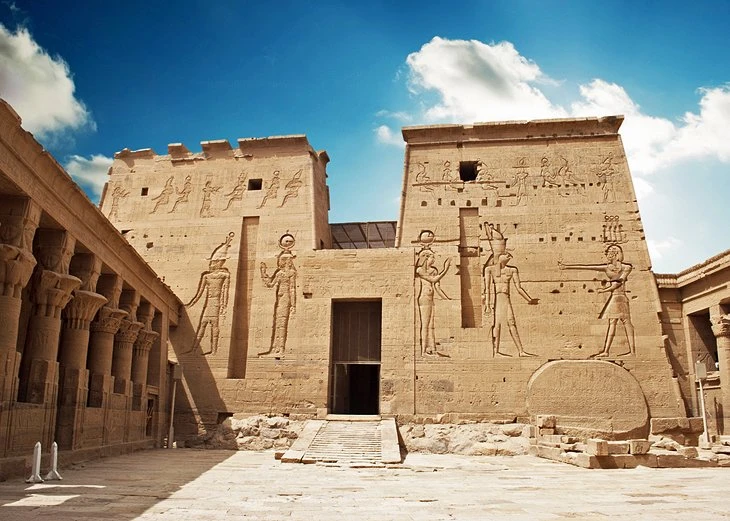The ancient Temple of Philae was dedicated to the goddess Isis. Discover the temple's history, architecture, myths of goddess Isis and tourist information.

History provides insights into the events, cultures, places and people who have shaped the world we live in today. In ancient Egypt, the Temple of Philae, an ancient temple complex, was a prominent center of Egyptian religious worship, particularly dedicated to the goddess Isis.
The temple originally was situated on Philae Island near the expansive First Cataract of the Nile in Upper Egypt. However, due to flooding caused by the Aswan Low Dam, it was dismantled and moved to nearby Agilkia Island as part of the UNESCO Nubia Campaign project before the completion of the Aswan High Dam in 1970.
Today, the island-based temple of Philae can be found on Agilkia Island near Aswan, Egypt. Tourists reach the temple by boat from the mainland.
Architecture of the Temple of Philae
The Temple of Philae was built during the reign of the final dynasty of ancient Egypt, the Ptolemaic period. The building began with Ptolemy II, and later other rulers added to it. The building structure is characterized by traditional style features such as halls, courtyards, and sanctuaries decorated with intricate hieroglyphs and carvings depicting the gods and goddesses, and various Egyptian mythology stories of ancient Egypt.
The statues of prominent deities the temple features that are currently recorded are Isis, Osiris, and Horus. Notably, in front of the temple’s pylon (entrance gateway), there originally stood two granite obelisks and two granite lions.
The gateway itself, adorned with reliefs by Ptolemy II Philadelphus and Emperor Tiberius, was built by Philadelphus and originally stood in a brick wall.
Goddess Isis, the Temple of Philae and Its Significance
After the building of the temple of Philae, it was dedicated to Isis, the goddess associated with healing, birth, and magic, alongside her husband Osiris and their son Horus. The worship of Isis remained one of the final bastions of ancient Egyptian religious practice following the spread of Christianity around 550 AD.
The significance of the Temple of Philae lies in its role as one of the most important centers of worship for Isis during the Ptolemaic and Roman periods. Pilgrims from across Egypt and beyond visited the temple to seek healing, guidance, and blessings from Isis. The temple complex, with its elaborate architecture and sacred surroundings, served as a focal point for religious ceremonies, rituals, and festivals dedicated to the goddess.
As one of the last strongholds of ancient Egyptian religious tradition before the rise of Christianity, the Temple of Philae holds historical importance in preserving the cultural heritage and spiritual beliefs of ancient Egypt.
Myth of the Temple of Philae
The Temple of Philae is associated with several myths and legends from ancient Egyptian mythology, primarily revolving around the goddess Isis, her husband Osiris, and their son Horus.
Here are some key myths related to the Temple of Philae:
- Osiris and Isis: One of the central myths involves Osiris, the god of the afterlife, and Isis, his wife and sister. Osiris was murdered by his brother Seth, who dismembered his body and scattered the parts across Egypt. Isis, with the help of her sister Nephthys and the god Anubis, searched for and reassembled Osiris's body. She used her magic to resurrect Osiris long enough to conceive their son, Horus.
- Birth of Horus: After resurrecting Osiris, Isis hid with Horus in the marshes of the Nile Delta to protect him from Seth's wrath. Isis played a crucial role in nurturing and protecting Horus, who later avenged his father's death by defeating Seth in a series of battles.
- Isis and the Seven Scorpions: Another myth recounts how Isis protected her infant son Horus from seven scorpions sent by Seth. She negotiated with Ra, the sun god, to save her child and was granted protection for Horus.
- Isis and Ra's Secret Name: In this myth, Isis sought to gain power by learning Ra's secret name, which held great magical significance. She tricked Ra into revealing his secret name to her, thereby gaining power over him and becoming a powerful goddess in her own right.
These myths and legends associated with Isis and the Temple of Philae illustrate her importance in Egyptian mythology as a goddess of magic, healing, protection, and motherhood. The temple served as a place of pilgrimage and worship where devotees sought blessings and guidance from Isis, emphasizing her role as a central figure in ancient Egyptian religious beliefs.
The Destruction of the Temple of Philae
Temple of Philae faced numerous challenges that nearly led to its destruction due to significant religious and political changes over the centuries.
The Spread of Christianity
In the 4th century AD, Christianity began to spread throughout Egypt, gradually becoming the dominant religion. By 550 AD, Byzantine Emperor Justinian ordered the closure of many ancient temples, including the Temple of Philae. The goal was to eradicate pagan worship and promote Christianity.
The temple was converted into a Christian church, marking the end of traditional Egyptian religious practices at the site. Many pagan images and symbols were defaced or removed to align with Christian beliefs, leading to significant alterations and damage to the temple's original structures and artworks.
The Arab Conquest of Egypt
In 641 AD, Arab forces conquered Egypt, bringing Islam to the region. The new rulers aimed to establish Islamic dominance and convert existing religious sites for Islamic use. Much of the Temple of Philae's religious monuments were destroyed during this period to repurpose the site.
The intent was to replace the old religious symbols with those reflecting the new Islamic faith. However, some original structures were left intact due to their historical significance. This period marked another significant phase of the temple's decline as ancient Egyptian religious practices were further suppressed.
Temple of Philae's Information for Tourism
Do you want to explore the fascinating Philae Temple complex in Egypt? Here are basic information you need to know about the temple.
Opening Hours
The normal visiting hours for the Temple of Philae are from Monday to Sunday, 7:00 am to 4:00 pm. Night shows are also held, usually between 21:00 and 22:00, with varying schedules based on the season.
Ticket Prices
If you visit independently, the entrance fee is 100 EGP for adults and 50 EGP for accredited students.
How to Get There
The Temple of Philae is located on Agilkia Island near Aswan in Egypt. Most tourists arrive by boat from the mainland to explore the temple complex.
Tours
Tours often start at the oldest part of the Temple of Isis, known as the Kiosk of Nectanebo. The entrance is marked by an 18m-high First Pylon decorated with reliefs of Ptolemy XII Neos Dionysos smiting enemies.
Conclusion
The Temple of Philae stands as a lasting symbol of ancient Egyptian religious devotion and architectural brilliance. Originally situated on Philae Island and later relocated to Agilkia Island to avoid flooding from the Aswan High Dam, the temple represents the enduring legacy of the goddess Isis and her importance in Egyptian mythology.
Despite facing destruction due to Christianity's spread and later the Arab conquest, UNESCO and others have worked to preserve its cultural heritage. Today, visitors can admire its intricate carvings, delve into its mythical tales, and experience its historical significance firsthand.

